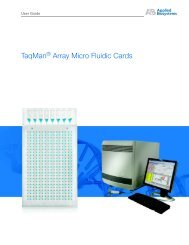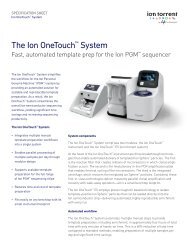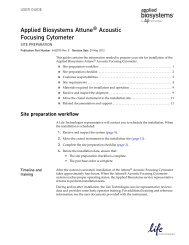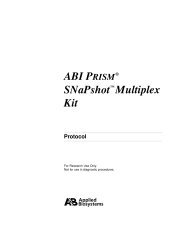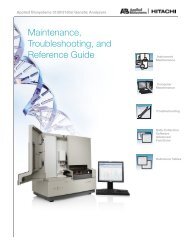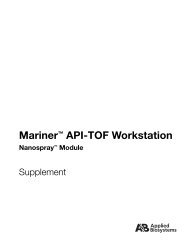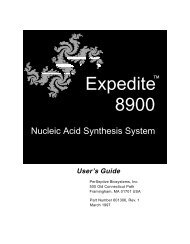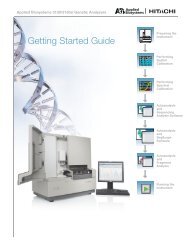miRNA Research Guide - Applied Biosystems
miRNA Research Guide - Applied Biosystems
miRNA Research Guide - Applied Biosystems
You also want an ePaper? Increase the reach of your titles
YUMPU automatically turns print PDFs into web optimized ePapers that Google loves.
Pre-miR <strong>miRNA</strong> Precursor Molecules<br />
Synthetic <strong>miRNA</strong> molecules for up-regulation of specific <strong>miRNA</strong> levels in cells<br />
Pre-miR <strong>miRNA</strong> Precursor Molecules (patent pending) are chemically modified and<br />
optimized nucleic acids designed to closely mimic the <strong>miRNA</strong> molecules in cells.<br />
The Pre-miR <strong>miRNA</strong> Precursor Molecules are designed to directly enter into the<br />
<strong>miRNA</strong> processing pathway, and are treated identically to endogenous <strong>miRNA</strong><br />
within the cell. With the Pre-miR <strong>miRNA</strong> Precursor Molecules, you can:<br />
• Control specific <strong>miRNA</strong> activity<br />
• Tightly regulate <strong>miRNA</strong> cellular levels<br />
• Achieve optimal delivery efficiency with minimal cytotoxicity<br />
For a synthetic <strong>miRNA</strong> to be useful, it must be active, robust, and most importantly,<br />
stranded. As pointed at by Schwarz et al.*, small double-stranded RNAs<br />
like siRNAs and <strong>miRNA</strong>s exhibit strandedness wherein one of the two complementary<br />
RNAs in the dsRNA molecule is preferentially incorporated into the<br />
<strong>miRNA</strong> (or siRNA) pathway. The sequence compositions and duplex stabilities of<br />
the small RNA molecules dictate which strand will be active in the cell.<br />
Transfected <strong>miRNA</strong>s should be similarly stranded to ensure efficient uptake of<br />
the active <strong>miRNA</strong> strand and occlusion of the incorrect, complementary strand.<br />
Since the Pre-miR <strong>miRNA</strong> Precursor Molecules directly enter the <strong>miRNA</strong> pathway,<br />
they eliminate any non-<strong>miRNA</strong> cellular response that is seen with siRNA-like<br />
designs. Unlike plasmid-based <strong>miRNA</strong> expression, the Pre-miR <strong>miRNA</strong> Precursor<br />
Molecules are easy to transfect with minimal cellular stress, and are able to be<br />
tightly regulated for specific dose response analysis.<br />
ORDERING INFORMATION<br />
Product Cat. # SIZE<br />
Pre-miR <strong>miRNA</strong> Precursor Molecules 17100 5 nmol<br />
order online at www.ambion.com/catalog/mirna_search.php 17101 20 nmol (4x5 nmol)<br />
Pre-miR <strong>miRNA</strong> Precursor Molecules custom defined sequence 17103<br />
order online at www.ambion.com/catalog/mirna_search.php<br />
20 nmol<br />
Pre-miR Negative Control #1 17110 5 nmol<br />
Pre-miR Negative Control #2 17111 5 nmol<br />
siPORT NeoFX Transfection Agent<br />
Transfection of small RNAs and co-transfection of <strong>miRNA</strong>s/pMIR-REPORT<br />
siPORT NeoFX’s lipid-based formulation can be used to efficiently transfect many<br />
cell types—especially adherent cells as they are subcultured—without increased<br />
cytotoxicity. From start to finish, successful gene silencing experiments can be<br />
completed in as early as 24 hours. This streamlined “neofection” protocol can be<br />
adapted to a wide range of cells and experimental designs, including highthroughput<br />
applications. NeoFX Transfection Agent efficiently transfects low concentrations<br />
of <strong>miRNA</strong> and siRNA. For example, high levels of siPORT NeoFXmediated<br />
gene silencing (>80%) were achieved by transfection of as little as<br />
0.1–10 nM siRNA (targeting GAPDH) into HeLa cells.<br />
ORDERING INFORMATION<br />
Product Cat. # SIZE<br />
siPORT NeoFX Transfection Agent 4510 0.4 ml<br />
4511 1 ml<br />
*Schwarz DS, Hutvagner G, Du T, Xu Z, Aronin N, Zamore PD. (2003) Asymmetry in the assembly of the RNAi enzyme<br />
complex. Cell. 115(2):199-208.<br />
www.ambion.com/<strong>miRNA</strong><br />
microRNA Functional Analysis<br />
pMIR-REPORT <strong>miRNA</strong> Expression<br />
Reporter Vector<br />
Sensitive, quantitative monitoring of <strong>miRNA</strong> expression<br />
The pMIR-REPORT <strong>miRNA</strong> Expression Reporter Vector provides accurate, quantitative,<br />
in-cell measurement of <strong>miRNA</strong> expression. This validated reporter system<br />
contains two mammalian expression vectors (Figure 24). pMIR-REPORT contains<br />
Luciferase under the control of a mammalian promoter/terminator system, with<br />
a <strong>miRNA</strong>-target cloning region downstream of the luciferase translation<br />
sequence. This vector is optimized for cloning of <strong>miRNA</strong> targets in order to evaluate<br />
<strong>miRNA</strong> regulation. A second vector, pMIR-REPORT Beta-gal Control Vector,<br />
is provided to normalize for transfection efficiency.<br />
The pMIR-REPORT <strong>miRNA</strong> Expression Reporter Vector is designed for the<br />
cloning and testing of putative <strong>miRNA</strong> binding sites. pMIR-REPORT can be transfected<br />
into mammalian cells to evaluate endogenous <strong>miRNA</strong> expression, or used<br />
to evaluate up- and down-regulation from Pre-miR <strong>miRNA</strong> Molecules and AntimiR<br />
<strong>miRNA</strong> Inhibitor Molecules, respectively. The pMIR-REPORT <strong>miRNA</strong><br />
Expression Reporter Vector can also be used as a sequence screening tool to<br />
identify <strong>miRNA</strong> targets or screen libraries of Pre-miR <strong>miRNA</strong> Molecules to identify<br />
genes that regulate expression.<br />
A<br />
CMV Promoter: 2210–2813<br />
Luciferase: 540–2210<br />
MCS: 467–539<br />
SV40 PolyA: 404–467<br />
SV40 Promoter: 6139–6438<br />
Puromycin: 5447–6046<br />
SV40 pA signal: 5153–5188<br />
Ampicillin: 4083–4943<br />
ColE1 origin: 3138–4024<br />
B<br />
CMV Promoter: 3627–4232<br />
βgal: 463–3627<br />
SV40 polyA: 404–463<br />
SV40 Promoter: 7524–7849<br />
Neomycin: 6691–7485<br />
SV40 pA signal: 6388–6638<br />
Ampicillin: 5504–6364<br />
ColE1 Origin: 4561–5447<br />
(6438)<br />
SV40 Promoter<br />
(6139)<br />
(6046)<br />
Puromycin<br />
(5447)<br />
(5188)<br />
SV40 pA<br />
(5153)<br />
SspI (4961)<br />
(4943)<br />
Ampicillin<br />
DraII (8044)<br />
(7849)<br />
SV40 Promoter<br />
(7524)<br />
(1)<br />
(7485)<br />
Neomycin<br />
(6691)<br />
(6638)<br />
SV40 pA<br />
(6388)<br />
(6364)<br />
Ampicillin<br />
(5504)<br />
(5447)<br />
(4083)<br />
(4024)<br />
ColE1 Origin<br />
ColE1 Origin<br />
(4561)<br />
EcoRI (4229)<br />
SV40 polyA<br />
NotI (407)<br />
NotI (407)<br />
SV40 polyA<br />
HindIII (463)<br />
pMIR-REPORT<br />
Beta-gal Control Vector<br />
8054 bp<br />
BamHI (3626)<br />
CMV Promoter<br />
BamHI (2205)<br />
ORDERING INFORMATION<br />
Product Cat. # SIZE<br />
EcoRI (1609)<br />
CMV Promoter<br />
EcoRI (2808)<br />
(3138)<br />
pMIR-REPORT <strong>miRNA</strong> Expression Reporter Vector 5795 1 kit (supercoiled<br />
plasmids in E. coli)<br />
(1)<br />
MCS<br />
pMIR-REPORT<br />
<strong>miRNA</strong> Expression Reporter<br />
6470 bp<br />
βgal<br />
HindIII (463)<br />
PmeI (476)<br />
MluI (495)<br />
NaeI (507)<br />
SacI (519)<br />
SpeI (525)<br />
Luciferase<br />
Figure 24. (A) pMIR-REPORT <strong>miRNA</strong> Expression Reporter Vector. (B) pMIR-REPORT<br />
β-Galactosidase Control Vector.<br />
13



